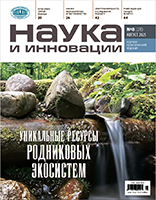
Новости НАН Беларуси
- Делегация НАН Беларуси приняла участие в 13-й международной промышленной выставке INNOPROM
- Международная научно-практическая конференция "Картофелеводство Беларуси: достижения и перспективы"
- Заместитель Премьер-министра Республики Беларусь Игорь Петришенко ознакомился с результатами археологических раскопок городища на Менке
- Участие в неделе предпринимательства Сучжоу для международных талантов
- На археологическом комплексе на реке Менка обнаружен еще один фрагмент посуды с родовым знаком князя Изяслава
Наши партнеры





New soil-improving additives for Cs polluted radioactive lands
Ihar Cheshyk, Director, Institute of Radiobiology, National Academy of Sciences of Belarus, Candidate of Medical Sciences, associate professor;
Aleksander Nikitin, Head, Laboratory of Radioecology, Institute of Radiobiology, National Academy of Sciences of Belarus, Candidate of Agricultural Sciences.
Summary.
The article considers the research results on the soil improvers reducing the transfer of the radioactive cesium isotope into plants. The soil improvers are based on biochar and a complex of microorganisms (lactic acid and purple bacteria, yeast fungi). It is shown that designed improvers can reduce the bioavailability of 137Cs and its transition to the aboveground parts of plants while having a positive effect on their growth and development.
Key words: cesium, biochar, accumulation coefficient, wheat, vegetables.
References.
1. Harris, P. On charcoal / P. Harris // Interdisciplinary Science Reviews. – 1999. – Vol. 24, N 4. – P. 301–306.
2. Cheng, C.-H. Stability of black carbon in soils across a climatic gradient / C.-H. Cheng [et al.] // Journal of Geophysical Research: Biogeosciences. – 2008. – Vol.113, N 2. – P. 20–27.
3. Glaser, B. The ’terra preta’ phenomenon: A model for sustainable agriculture in the humid tropics / B. Glaser [et al.] // Naturwissenschaften. – 2001. – Vol. 88. The ’terra preta’ phenomenon, N 1. – P. 37–41.
4. Swiatkowski, A. Influence of the surface chemistry of modified activated carbon on its electrochemical behavior in the presence of lead(II) ions / A. Swiatkowski [et al.] // Carbon. – 2004. – Vol. 42, N 15. – P. 3057–3069.
5. Roussel-Debet S. Screening the importance of soil micro-organisms on radionuclides mobility / S. Roussel-Debet, S. Deneux-Mustin, C. Munier-Lamy // Radioprotection. – 2005. – Vol. 40. – P. S87–S91.
6. Lloyd, J.R. Microbial transformations of radionuclides : Fundamental mechanisms and biogeochemical implications / J.R. Lloyd, J.C. Renshaw // Metal Ions in Biological Systems. – 2005. – Vol. 44. Microbial transformations of radionuclides. – P. 205–240.
7. Kato, F. Accumulation and subcellular localization of cesium in mycelia of streptomyces lividans and a Cs tolerant strain, streptomyces sp. Toho-2. / F. Kato [et al.] // Journal of Health Science. – 2000. – Vol. 46, N 4. – P. 259–262.
8. Perkins, J. The influence of ph and external h+ concentration on caesium toxicity and accumulation inescherichia coli andbacillus subtilis / J. Perkins, G.M. Gadd // Journal of Industrial Microbiology. – 1995. – Vol. 14, N 3–4. – P. 218–225.
9. Ohnuki, T. Effect of minerals on accumulation of cs by fungus saccaromyces cerevisiae / T. Ohnuki [et al.] // Journal of Environmental Radioactivity. – 2015. – Vol. 144. – P. 127–133.
10. Sasaki, H. Accumulation of radioactive cesium released from fukushima daiichi nuclear power plant in terrestrial cyanobacteria nostoc commune / H. Sasaki [et al.] // Microbes and Environments. – 2013. – Vol.28, N 4. – P. 466–469.
11. Mahmoud, Y.A. Uptake of radionuclides by some fungi / Y.A. Mahmoud // Mycobiology. – 2004. – Vol. 32, N 3. – P. 110–114.
12. Ehlken, S. Environmental processes affecting plant root uptake of radioactive trace elements and variability of transfer factor data: A review / S. Ehlken, G. Kirchner // Journal of Environmental Radioactivity. – 2002. – Vol. 58. – N2–3. – P. 97–112.
13. Higa, T. Effective microorganisms: A biotecnology for mankind / T. Higa // Proceedings of the 1st international conference on kyusei nature farming. – Washington, DC, 1991. Effective microorganisms. – P. 8–14.
14. Pareniuk, O. Modification of 137Cs transfer to rape (brassica napus l.) phytomass under the influence of soil microorganisms / O. Pareniuk [et al.] // Journal of Environmental Radioactivity. – 2015. – Vol. 149. – P. 73–80.
15. Djedidi, S. Evaluation of the possibility to use the plant-microbe interaction to stimulate radioactive 137cs accumulation by plants in a contaminated farm field in fukushima, japan / S. Djedidi [et al.] // Journal of Plant Research. – 2014. – Vol. 128, N 1. – P. 147–159.
Вход для пользователей
Новые обсуждения форума
Опрос
Сейчас на сайте
Сейчас на сайте 0 пользователей и 3 гостя.



